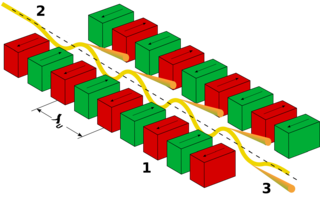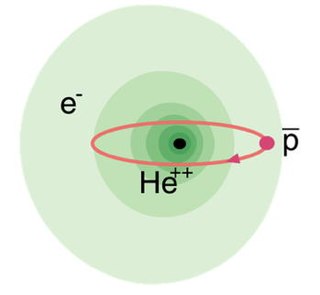Related Research Articles

DESY, short for Deutsches Elektronen-Synchrotron, is a national research centre for fundamental science located in Hamburg and Zeuthen near Berlin in Germany. It operates particle accelerators used to investigate the structure, dynamics and function of matter, and conducts a broad spectrum of interdisciplinary scientific research in four main areas: particle and high energy physics; photon science; astroparticle physics; and the development, construction and operation of particle accelerators. Its name refers to its first project, an electron synchrotron. DESY is publicly financed by the Federal Republic of Germany and the Federal States of Hamburg and Brandenburg and is a member of the Helmholtz Association.

SLAC National Accelerator Laboratory, originally named the Stanford Linear Accelerator Center, is a federally funded research and development center in Menlo Park, California, United States. Founded in 1962, the laboratory is now sponsored by the United States Department of Energy and administrated by Stanford University. It is the site of the Stanford Linear Accelerator, a 3.2 kilometer (2-mile) linear accelerator constructed in 1966 that could accelerate electrons to energies of 50 GeV.

A linear particle accelerator is a type of particle accelerator that accelerates charged subatomic particles or ions to a high speed by subjecting them to a series of oscillating electric potentials along a linear beamline. The principles for such machines were proposed by Gustav Ising in 1924, while the first machine that worked was constructed by Rolf Widerøe in 1928 at the RWTH Aachen University. Linacs have many applications: they generate X-rays and high energy electrons for medicinal purposes in radiation therapy, serve as particle injectors for higher-energy accelerators, and are used directly to achieve the highest kinetic energy for light particles for particle physics.

A synchrotron light source is a source of electromagnetic radiation (EM) usually produced by a storage ring, for scientific and technical purposes. First observed in synchrotrons, synchrotron light is now produced by storage rings and other specialized particle accelerators, typically accelerating electrons. Once the high-energy electron beam has been generated, it is directed into auxiliary components such as bending magnets and insertion devices in storage rings and free electron lasers. These supply the strong magnetic fields perpendicular to the beam that are needed to stimulate the high energy electrons to emit photons.

An undulator is an insertion device from high-energy physics and usually part of a larger installation, a synchrotron storage ring, or it may be a component of a free electron laser. It consists of a periodic structure of dipole magnets. These can be permanent magnets or superconducting magnets. The static magnetic field alternates along the length of the undulator with a wavelength . Electrons traversing the periodic magnet structure are forced to undergo oscillations and thus to radiate energy. The radiation produced in an undulator is very intense and concentrated in narrow energy bands in the spectrum. It is also collimated on the orbit plane of the electrons. This radiation is guided through beamlines for experiments in various scientific areas.

A free-electron laser (FEL) is a fourth generation light source producing extremely brilliant and short pulses of radiation. An FEL functions much as a laser but employs relativistic electrons as a gain medium instead of using stimulated emission from atomic or molecular excitations. In an FEL, a bunch of electrons passes through a magnetic structure called an undulator or wiggler to generate radiation, which re-interacts with the electrons to make them emit coherently, exponentially increasing its intensity.

The Paul Scherrer Institute (PSI) is a multi-disciplinary research institute for natural and engineering sciences in Switzerland. It is located in the Canton of Aargau in the municipalities Villigen and Würenlingen on either side of the River Aare, and covers an area over 35 hectares in size. Like ETH Zurich and EPFL, PSI belongs to the Swiss Federal Institutes of Technology Domain of the Swiss Confederation. The PSI employs around 2,100 people. It conducts basic and applied research in the fields of matter and materials, human health, and energy and the environment. About 37% of PSI's research activities focus on material sciences, 24% on life sciences, 19% on general energy, 11% on nuclear energy and safety, and 9% on particle physics.

Spallation is a process in which fragments of material (spall) are ejected from a body due to impact or stress. In the context of impact mechanics it describes ejection of material from a target during impact by a projectile. In planetary physics, spallation describes meteoritic impacts on a planetary surface and the effects of stellar winds and cosmic rays on planetary atmospheres and surfaces. In the context of mining or geology, spallation can refer to pieces of rock breaking off a rock face due to the internal stresses in the rock; it commonly occurs on mine shaft walls. In the context of anthropology, spallation is a process used to make stone tools such as arrowheads by knapping. In nuclear physics, spallation is the process in which a heavy nucleus emits numerous nucleons as a result of being hit by a high-energy particle, thus greatly reducing its atomic weight. In industrial processes and bioprocessing the loss of tubing material due to the repeated flexing of the tubing within a peristaltic pump is termed spallation.
A particle beam is a stream of charged or neutral particles. In particle accelerators, these particles can move with a velocity close to the speed of light. There is a difference between the creation and control of charged particle beams and neutral particle beams, as only the first type can be manipulated to a sufficient extent by devices based on electromagnetism. The manipulation and diagnostics of charged particle beams at high kinetic energies using particle accelerators are main topics of accelerator physics.

Antiprotonic helium is a three-body atom composed of an antiproton and an electron orbiting around a helium nucleus. It is thus made partly of matter, and partly of antimatter. The atom is electrically neutral, since both electrons and antiprotons each have a charge of −1, whereas helium nuclei have a charge of +2. It has the longest lifetime of any experimentally producible matter-antimatter bound state.
The National Synchrotron Light Source (NSLS) at Brookhaven National Laboratory (BNL) in Upton, New York was a national user research facility funded by the U.S. Department of Energy (DOE). Built from 1978 through 1984, and officially shut down on September 30, 2014, the NSLS was considered a second-generation synchrotron.

Daresbury Laboratory is a scientific research laboratory based at Sci-Tech Daresbury campus near Daresbury in Halton, Cheshire, England. The laboratory began operations in 1962 and was officially opened on 16 June 1967 as the Daresbury Nuclear Physics Laboratory (DNPL) by the then Prime Minister of United Kingdom, Harold Wilson. It was the second national laboratory established by the British National Institute for Research in Nuclear Science, following the Rutherford High Energy Laboratory. It is operated by the Science and Technology Facilities Council, part of UK Research and Innovation. As of 2018, it employs around 300 staff, with Paul Vernon appointed as director in November 2020, taking over from Professor Susan Smith who had been director from 2012.
Accelerators and Lasers In Combined Experiments (ALICE), or Energy Recovery Linac Prototype (ERLP) is a 35MeV energy recovery linac test facility at Daresbury Laboratory in Cheshire, England. The project was originally conceived as a test bed for the 4th Generation Light Source (4GLS), and consists of:

ASTRID2 is a synchrotron light source at the Department of Physics and Astronomy of Aarhus University. ASTRID2 was designed, constructed and is operated by the Centre for Storage Ring Facilities in Aarhus (ISA).

The Swiss Light Source (SLS) is a synchrotron located at the Paul Scherrer Institute (PSI) in Switzerland for producing electromagnetic radiation of high brightness. Planning started in 1991, the project was approved in 1997, and first light from the storage ring was seen at December 15, 2000. The experimental program started in June 2001 and it is used for research in materials science, biology and chemistry.

The European X-Ray Free-Electron Laser Facility is an X-ray research laser facility commissioned during 2017. The first laser pulses were produced in May 2017 and the facility started user operation in September 2017. The international project with twelve participating countries; nine shareholders at the time of commissioning, later joined by three other partners, is located in the German federal states of Hamburg and Schleswig-Holstein. A free-electron laser generates high-intensity electromagnetic radiation by accelerating electrons to relativistic speeds and directing them through special magnetic structures. The European XFEL is constructed such that the electrons produce X-ray light in synchronisation, resulting in high-intensity X-ray pulses with the properties of laser light and at intensities much brighter than those produced by conventional synchrotron light sources.
FLASH, acronym of Free Electron LASer in Hamburg, is a superconducting particle accelerator-based soft X-ray free-electron laser located at the German national laboratory DESY in Hamburg, Germany. It can generate very powerful, ultrashort pulses (~10−14 s) of coherent radiation in the energy range from 10 eV (electronvolt) to 300 eV. It started operation for external users in the year 2005 and is used for surface, molecular and atomic physics experiments. Intended applications are also the imaging of single biological complex molecules with time resolution.

A particle accelerator is a machine that uses electromagnetic fields to propel charged particles to very high speeds and energies, and to contain them in well-defined beams.

The Helmholtz-Zentrum Dresden-Rossendorf (HZDR) is a Dresden-based research laboratory. It conducts research in three of the Helmholtz Association's areas: materials, health, and energy. HZDR is a member of the Helmholtz Association of German Research Centres.
Atomic Spectroscopy and Collisions Using Slow Antiprotons (ASACUSA), AD-3, is an experiment at the Antiproton Decelerator (AD) at CERN. The experiment was proposed in 1997, started collecting data in 2002 by using the antiprotons beams from the AD, and will continue in future under the AD and ELENA decelerator facility.
References
- ↑ "SwissFEL inauguration". Paul Scherrer Institute. Retrieved 2020-03-16.
- ↑ "Beginning of construction in the Würenlingen forest". Paul Scherrer Institute. Retrieved 2020-03-16.
- ↑ "SwissFEL ready for assembly". Paul Scherrer Institute. Retrieved 2020-03-16.
- ↑ "First experiment at SwissFEL carried out successfully". Paul Scherrer Institute. Retrieved 2020-03-16.
- ↑ "First Pilot Experiment at SwissFEL-Alvra on UV photo-induced charge transfer in OLED system". Paul Scherrer Institute. Retrieved 2020-03-16.
- ↑ "ATHOS Conceptual Design Report 2017". Paul Scherrer Institute. p. 13. Retrieved 2020-03-16.
- ↑ "Hollywood in the Würenlingen woods". Paul Scherrer Institute. Retrieved 2020-03-16.
- 1 2 "Perfect beamlines go unnoticed". Paul Scherrer Institute. Retrieved 2020-03-16.
- 1 2 3 "The SwissFEL X-ray free-electron laser". Paul Scherrer Institute. Retrieved 2020-03-16.
- 1 2 "SwissFEL – the new large-scale facility at the Paul Scherrer Institute". Paul Scherrer Institute. Retrieved 2020-03-16.
- ↑ Walter Hagenbüchle (2018-10-14). "Das Paul-Scherrer-Institut betreibt jene Art von Forschung, die einen langen Atem braucht". Neue Zürcher Zeitung. Retrieved 2020-03-16.